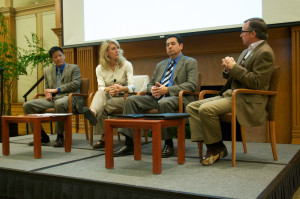During a panel discussion Tuesday night at the Bechtel Conference Center, Bay Area law enforcement officers discussed how changes in the approach and investigation of human trafficking by local San Jose and San Francisco departments have increased the level of efficacy in addressing these issues.
“Human trafficking in the Bay Area is alive and well,” said John Vanek, a retired lieutenant of the San Jose Human Trafficking Task Force at the talk, which was hosted by the Freeman Spogli Institute for International Studies.
According to Vanek, the San Jose task force was one of the first in the nation to receive funding from the U.S. government to combat human trafficking in 2006. He said the unit’s four goals are to identify and rescue victims of trafficking, prosecute offenders, train law enforcement officers and raise community awareness.

Human trafficking crimes are often revealed because of restaurant and wage dispute issues, domestic violence and identity fraud cases, according to Sgt. Kyle Oki, a member of the San Jose task force.
For this reason the San Francisco Police Department (SFPD), represented by Capt. Antonio Parra, has integrated a dozen specialized investigative disciplines, under one roof and one commanding officer, into a Special Victims Unit, created in Oct. 2011. Capt. Parra is the commanding officer of the SVU.
The unit, with a mission to “investigate crimes of abuse, in its various forms, committed against our most vulnerable,” incorporates 12 specialized investigative disciplines including child abuse, domestic violence, sex crimes, human trafficking, missing persons, vice/first offender, prostitution, registered sex offenders, Internet crimes against children, financial crime, psychological liaison and elder abuse.”
According to Capt. Parra, the centralization of these disciplines “gives versatility and a team approach to investigations which has been very effective.”
“We’re successful [at helping victims] because we changed our philosophical approach,” Capt. Parra continued.
Sgt. Arlin Vanderbilt said that the SFPD “begins with a focus on the victim, not just the prosecution.” His colleague, Lt. Jason Fox, also stated that crime suspects may be re-categorized as human trafficking victims.
Of the reported human trafficking victims in the South Bay, 80 to 90 percent are women, with ages ranging from 14 to 60, according to Sgt. Oki. He added that in San Jose, 80 percent of victims originate from labor trafficking as opposed to the sex trade. The girls that are trafficked through the sex trade usually protest to the police officers that they are “in love with the pimp,” which make them reluctant to talk to law enforcement, he added.
Sgt. Oki emphasized that these girls are “locally born in San Jose and Oakland” and are often manipulated by men when they are 14 or younger. Two girls recently rescued, he said, were transported from San Jose, to Los Angeles, to Virginia and finally to Baltimore.
“There are victims everywhere and people need to be vigilant,” Sgt. Oki added.
According to Vanek, a recent survey of recovered victims showed that there were, on average, eight or nine times when someone could have saved the victim earlier but no action was taken. He said that this happens often because observers do not know what measures to take.
“It’s interesting to get a sense of the different perspectives,” said audience member Desmond Lim ‘14 of the panel. “Learning what officers on the ground are doing was very valuable.”